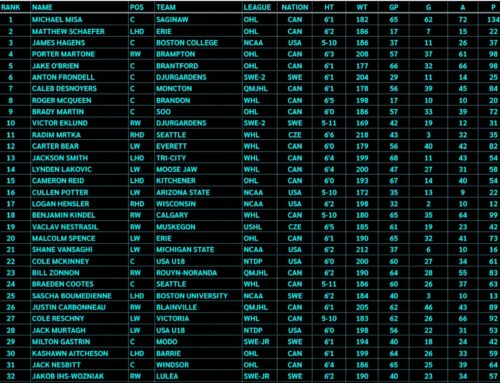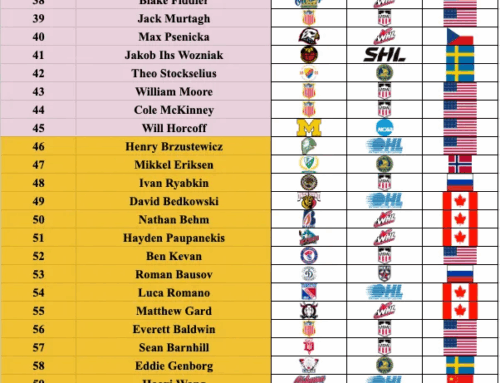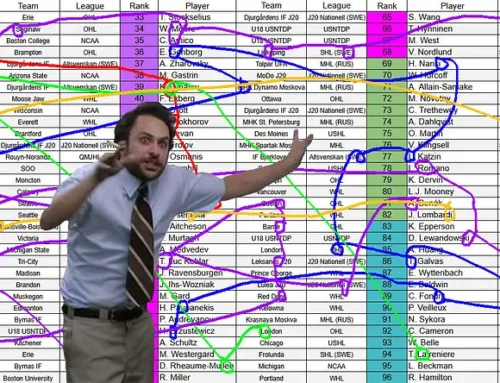Draft Class Deep Dive: C Quinton Byfield
Tony Ferrari
2020-09-23
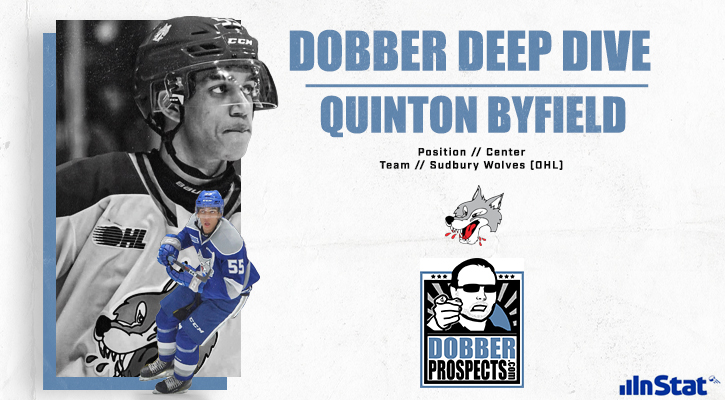
Feature image courtesy of Andrew Armstrong
What if I told you that there was a player who stood at 6’4″ and 215lbs but he had all the agility of a high-level player who was 5’11” and 180lbs? How intriguing would that same player be if he was an elusive and skilled playmaker who had the ability to spot teammates in any position with players draped over his back? If we are Now imagine that player with a shot that could touch 40 goals at the NHL level. If even-strength production is what you value, this might be your guy. Oh, and he’s a center. He also just turned 18 on August 19th, 2020 making him one of the youngest players in the 2020 NHL Draft.
Meet Quinton Byfield.
This season is the rare case fo having two talents at the top of the draft that very well could have been sure-fire number one picks in many others years. Since the 2010 NHL Draft, there would only be two years where Byfield isn’t a surefire number one (McDavid in ’15, Matthews in ’16) and two others where he would be in a battle for the top spot (MacKinnon in ’13, Dahlin in ’18). Outside of that, he would have been the surefire top prospect in six of ten years and possibly in two others. Split the difference and that equates to him being the top prospect in seven of the last ten years. There is even an argument that he could be worth the first overall pick this year.
For a player of Byfield’s quality, there seems to be a lot of naysayers. There have been complaints about everything from his “low IQ” to critiques over his skating stride. Both are unfounded and lazy critiques that some have used to justify ranking Byfield outside the top-three or -five. I think sometimes we get in our heads too much on a player and let minor critiques shape our overall opinion of a player just because he isn’t what you’d expect in a 6’4, 215lbs frame. As we work through this film study, it will be evident that IQ and skating are not his issues. Why some have focused on the negatives of Byfield’s game and not others such as Tim Stützle or Jamie Drysdale, will always confuse me. Let’s get into what makes Byfield a borderline franchise-altering player.
Goal Scoring Prowess
Quinton Byfield has a top-five shot in this draft class. Unfortunately, he is a true dual-threat player who thrives as a play driver and offensive creator so we don’t see his shot as often as some other players in the class with comparative shooting talent. The table below displays the shooting and goal-scoring data of some of the top North American goal scorers eligible for the draft. Byfield takes the least shots on goal of the group and his shot attempt (SHA) number isn’t much better, surpassing only Marco Rossi. Where Byfield moves to the upper half of the group is when you look at results based statistics such as shooting percentage (SH%) and how many of his shot attempts hit the net (SOG%). This indicates that although he isn’t getting as many shots on goal as his fellow draftees, he is able to make the attempt he takes count. His goals per game were third among the group with only Seth Jarvis and Jack Quinn finishing ahead of him. Also, it’s worth mentioning just how insane Alexis Lafrenière’s shot generation was this year.

Shooting data courtesy of InStat Hockey
Byfield’s efficient goal scoring and high-level scoring talent can mean a variety of things, based on how each individual perceives the problem. While some insist that he needs to be more aggressive, generating more shots for himself and being a more dangerous player with the puck on his stick. Other’s may argue that the reason that Byfield doesn’t have the same shot generation as the other players in this group is that he is the only player in this group that is not on a championship level roster. This forces more on Byfield’s shoulders and when you don’t have as much to work with, you often need to be the best player on the ice, making other players better, which Byfield was.
The perspective I choose to take on this aspect of his game is that between the eye-test and these statistics you have much to unlock. The Sudbury Wolves center possesses a heavy shot that he can release from all over the ice and score. His ability to dangle himself into space or the use of his skating to open up room makes him a truly difficult shooter to stop. If you can give Byfield a bit higher skill linemates, likely the case in any NHL top-six, he can unlock more of a goal-scoring touch. Even without the upgrade in linemates, asking Byfield to shoot the puck a bit more on his own should increase his scoring rate. Not bad for a player who was scoring at a 48-goal pace over a full OHL season.
One of the biggest advantages the big center has is that he is incredibly agile. At 6’4″ and over 200lbs, there are very few players in the world that have the agility and size that Byfield possesses. His ability to cut on a dime, use his strong edges and fluid footwork help create separation between himself and the defender. In the video above, we can see Byfield attacks the zone with speed, backing off the defender. As soon as the defenders dropped to his stomach to clog the lane and disrupt Byfield’s ability to make a play, the 6’4″ center cuts to the middle with ease and has all the room he needs to pick the corner.
A player who has the size and strength that ‘Q’ has should be an effective player on the cycle in the offensive zone. Strong on his feet and imposing physically, Byfield is able to effectively utilize the cycle game to rotate into scoring positions. He is strong on pucks along the boards, consistently poking them free to teammates and putting his body in the way of his opposition to ensure that his squad retains possession. As we view the next clip in our film study, Byfield uses his speed and reach to slow, then collect a puck shot around the boards. Cycling it down low then rotating to the slot, Byfield sits down in the soft zone and fires the puck from a high-danger area, making no mistake.
Byfield’s speed can make him lethal on any play, even if he looks out of it. He is able to get back into plays and carve defenses as he skates by defenders who have no way of stopping what seems like a freight train when he gets moving. Below we see a Sudbury teammate make a good move in the offensive zone before stopping up and realizing that he has no one in the attacking end with him. That is until a flash of blue and white light dragging two opposing players to the net flies down the slot. Making no mistake on the pass, the puck is in the back of the net by Byfield.
Today’s NHL has a higher skill level than ever before and it continues trending towards speed and skill more every year. Good hands in tight have become a hallmark of most of today’s best goal scorers. Whether it be Auston Matthews or Leon Draisaitl, the leagues best are able to put away pucks from in tight with quick and decisive hands. Byfield displays his hands from all over the ice and often opens up space with his puck control and reach, both of which aid him around the crease. Scoring a tweener for Team Canada at the Hlinka-Gretzky Cup, below, Byfield let people know early in the year that he wasn’t just a big body.
The Sudbury Wolves had a solid, yet unspectacular roster beyond Byfield. This often led to Byfield having to create his own shot from nothing. With impressive mobility, Byfield’s multi-directional skating allows him to get around the offensive zone. Often taking unique paths through the offensive zone, Byfield works off the boards or from above the faceoff circles regularly. Attacking the zone with speed, in the clip below we see Byfield get a bit ahead of the puck and stop up along the boards. Once approached by a defender, he makes a move and pivots as he enters the slot to get on his forehand and fires the puck. Moving east-west and pivoting the put the puck on the trail side of the movement throws a netminders angle off and with Byfield’s shot, he gains a massive advantage as a shooter in a high danger area.
As any player with his size should be, Byfield has the ability to be a net-front presence. Cleaning up the garbage by potting rebounds or redirecting pucks, Byfield has the skill, hand-eye, and strength to be an elite player in tight. In the video below, Byfield wins the faceoff back to his defenseman and then skates towards the net. Crossing the goaltender’s face as the shot comes through, the goalie is unable to smother the puck and gives up a small rebound that Byfield is able to bang into the net as he spins to his forehand. Using his frame and speed to get to the net front and cross the goaltender’s face which throws their vision off the loose puck that Byfield taps in. It isn’t common for a player to have the body control to turn and identify the puck in a scramble he he does here.
Efficient and skilled, Byfield is barely scratching the surface as a goal scorer. His heavy shot and accuracy allow him to beat netminders from anywhere on the ice. Getting into the slot is part of the reason that despite his relatively low shooting output, he is able to produce at a highly impressive rate.
If Byfield can increase his shooting volume, something that may come with maturity, he could very well be a high-level goal scorer at the NHL level. The young star should be a productive scorer who can top the 25-goal mark without much changing in his game but taking that step could lead to elite production in the 40-goal range. Much like the rest of Byfield’s game, with some refinement, there is nearly limitless potential.
Playmaker Extraordinaire
As one of the premier playmakers in the class, Byfield is an exceptional passer who uses his body, puck skills, and understanding of space to attack defenses and put his teammates in great scoring positions. In general, playmakers use east-west passing to move goalies, alter angles, and increase the likelihood that the shooter will be able to take advantage of the goalie’s movement. A factor of improved defensive systems over the years and more stringent offensive rush patterns and offensive zone structures, north-south passing, especially from forwards has become something of a lost art. When a forward skates above the dots and has the skill and precision to filter a puck through defensive schemes to a player low in the zone, it forces goaltenders to adjust in their crease but what it also does is alter the positioning of the defense. It forces them to turn 180 degrees in an effort to re-square themselves to the puck. This gives the pass recipient plenty of time to shoot or make another pass, generally into the slot.
Byfield is a gifted skater. He certainly has areas of his stride that he clean up as do the vast majority of players in their draft-eligible season. Does he skate a bit hunched over at times? Yes. Is he one of the best skaters in the draft class? Also, yes. In the clip below we get to see Byfield get the puck as he exits the defensive zone and transition up ice with speed. When he enters the attacking zone, he ramps his speed down and uses his high-level edge work as if he is a player who is 5’11” before using the strength that he has in his 6’4″ frame to protect the puck and make a pass. Byfield plays with physicality when needed, even if it’s not the big hits and trucking players that people saw with
Creativity is a trait that often doesn’t get attributed to Byfield’s game. The creativity in Byfield’s game is often subtle, done through unorthodox hand positioning, skating paths through the offensive zone, or his ability to go high-low or low-high in the attacking zone. These are all habits that breed creative offensive play. In our next video, we can see Byfield drive down the boards on the outside with the two defenders and first forward back all in a good position to just guide the Sudbury star to the outside and around the back of the net. With his head up and understanding the limited space and options, Byfield creates a dangerous chance with a bit of an unconventional pass. His hand positioning gets high up on his stick and close together, using them as a pivot point to spring the pass.
The draw that Byfield demands when he has the puck is only going to aid in his ability to make his teammates better. He shows the ability to pass in and through traffic, using his frame and strength to shield and gain body position. In our next clip of Byfield’s game, we can see him attack the middle of the ice as he enters the offensive zone. Once he receives the return pass, he is swarmed by the opposition. He is able to control the puck and problem-solve on the fly by identifying the space behind the bracketing defenders to get the puck to a dangerous scoring position.
The reason that Byfield is such an effective playmaker is that he is an unselfish goal scorer. This may play into what we will cover in a bit when it comes to concerns and confusion, but for now, we will focus on how it affects his playmaking and ability to drive play offensively. The threat of the young Canadian’s shot requires goaltenders and defensemen to respect it and not cheat to the open man. This is even more evident when Byfield is driving towards the net or has the puck deep in the offensive zone. His quick decision making and spatial awareness allow for him to use his magnetism to draw defenders in before passing to his teammates who have been given the extra space. In the play below, Byfield is able to drive the net, draw in his opponents and freeze the netminder with a very subtle opening of his stick blade in tight, leading to a tap-in on the backside.
Whether Byfield is creating chances with his vision or mobility, his ability to put the puck where his teammates find themselves in opportunistic situations. Understanding where the openings on the ice are and filtering the puck there are what Byfield does best. His understanding of the defenders being pulled in his direction, attacking with speed, and having the vision to find his teammates at all levels of the offensive zone, through traffic, anticipating the movement of both his own team but his adversary’s as well.
Concerns and Confusion
The reality of Byfield’s game is that there are areas of weakness and room for improvement. Every player in draft history has had flaws. That’s just how this works. What you have to look at when evaluating a player’s negative aspects is whether the weakness can be improved and how likely is it that this player improves. When we look at a player like Perfetti, we ask “Can he improve his skating stride?”. When we look at Sanderson, we ask “Where is his offensive ceiling?”. With Quinton Byfield, the biggest questions often surround two things. His defensive effort and his physicality.
Let’s address the defensive issue. Byfield is a bit of a lackadaisical defensive player at times. He likes to flee the defensive zone to attempt to spring offense at times as well. This isn’t an uncommon flaw for young players. In the video above, we can see Byfield being a bit lackadaisical as he wanders the defensive zone, putting in a half-hearted effort. His stick is long and it gets in the passing lanes but if he isn’t giving full effort, his excellent anticipation can’t be used as effectively. The big center needs to be a bit more consistent with his defensive play and utilize his speed and skill to pressure puck carriers and generate turnovers.
He played on the penalty kill with the Wolves but that is a skill set that he will need to continue to work on if he plans on doing it at the next level. Plays like the one below give a coach hope that there is something there. Byfield shows off his anticipation, skating, and skill. As he works at the top of the penalty kill, he keeps his stick in passing lanes and jumps right at the correct moment. Timing the pass perfectly and getting his stick on the puck. Collecting it in the neutral zone, Byfield is off the to races and, well, just watch the video.
In contrast to his effort in the defensive end, Byfield understands that when he makes a mistake or gives the puck away, he needs to be working to get it back. Seeming a bit annoyed with himself when he gives the opposition an opportunity, Byfield will skate hard on the backcheck and put forth that effort that he lacks at times defensively. In the clip below, Byfield loses the puck as he enters the offensive zone. Once the puck is heading the other way, Byfield gets on his horse and chases down the puck carrier. He gets to a good position and then lays a hit. His skating and strength allowed him to get out of the player’s blindspot before laying the hit, ensuring that he wasn’t making a dangerous play. This effort is a sign of what’s possible. If Byfield can get this effort level more consistently, his defensive play should improve drastically as he already has high-level anticipation and a strength and mobility combo that should profile as an above-average defensive center.
Now to the concerns about his physicality. There have been some concerns with his willingness to be physical and/or inability to play in traffic, which seem to be misguided. Not to say those concerns are wrong or invalid but some of them may be born out of misunderstanding. In a sense, the fact that Byfield is 6’4″ and 215lbs is the cause of that misunderstanding. Byfield’s frame automatically causes analysts and scouts to assume that he is a power forward or heavy hitter. The assumption that he must be the second coming of Eric Lindros always seemed odd. If you’ve ever watched Byfield play, you see that he is not that style of player. Byfield is a skilled player with size not a big player with skill. Although that seems to be the same thing at face value, it’s not.
When we look at a skilled player with size, we think of players like Evgeny Malkin or Auston Matthews. When we think of big players with skill, it is often Tom Wilson or Kevin Hayes. All four are very different players. All four play in a top-six role in the NHL. Malkin and Matthews are different animals. Byfield fits in that class. We’ve all seen Malkin get angry and go full “red mist” and absolutely crush a guy but his physicality game-in, game-out comes from his ability to establish body position. Matthews found his physicality in the latter half of the season and into the play-in round, none of it stemming from laying big hits. Rather he used his strength to hold off a defender with one arm and control the puck on his stick with another. Byfield will need to take steps towards using his physicality more often in both of those senses but the examples are anything but lacking, especially in the second half of the season. The reality is that part of the critique of Byfield comes from the misclassification of the type of player that he is. Byfield is a highly-skilled, playmaking center who drives play offensively at an elite rate. Sorry that he isn’t the power winger that some seem to wish he was.
Numbers Don’t Lie, Age is Deceiving
The NHL Draft is weird. The age cut-off is September 15th of the year which means, using this year as an example, you have players born in late-2001 in the same draft as players who were born in late summer of 2002. This factor often means that a player who is born in late-2001 will likely have more junior hockey experience and almost a full year of development at a time when it may be the most pivotal. Players make massive jumps in every area from production to physical maturity from the ages of 15-22. The ages of 17-19 are such important years from that perspective as players generally get to their full height and begin to fill out their frame with muscle. Around this age, players start to really understand the game and how their skill set is best used.
Quinton Byfield was born on August 19th, 2002. Alexis Lafrenière was born on October 11th, 2001. That is a difference of 312 days. Ten months and eight days. 85% of a full year. That leads to the question of how do they compare at the same age? While we can’t get an exact date-to-date match, we can take a look at their 17-year-old seasons. With Lafrenière being 15% younger during those seasons, we should expect him to be a bit behind in terms of production if we are being fair and using the same criteria to justify Byfield being younger when comparing both of their draft years. The chart below features their statistics from their 17-year-old seasons and the numbers are fairly comparable with Byfield coming out slightly ahead in his rate-based statistics, expectedly because of the aforementioned 15% age advantage in this scenario.

Quinton Byfield and Alexis Lafrenière 17-year-old season production. Courtesy of Pick224.com
The one area that Lafrenière does come out ahead is the goals-for department. His even-strength goals-for percentage and it’s relation to his team are better than Byfield. The relative number is quite a bit closer than the standard data which likely means Byfield’s goal-for data is impacted by the quality of the team around him, as is Lafrenière’s team affecting his. These numbers help give context as to how productive Byfield truly was this season and how impressive Lafrenière was in his draft minus-one season.
The World Juniors is another thing that Lafrenière seems to get the edge on Byfield in discussions. In one sense, it’s fair. Lafrenière was the best player at the tournament this year and it wasn’t close when he was on the ice. Byfield was on the fourth line and didn’t touch the ice in the gold medal game. Lafrenière was the better player at the 2020 World Junior Championships. However, we yet again look to Lafrenière’s 17-year-old year at the same event and we come away with a similar sentiment that we had with Byfield this year. Lafrenière had one goal at last year’s event. Byfield had one assist at this year’s. Neither were dominant as 17=year-old players at the U20 event. That’s not to say Byfield will tear the 2021 World Junior Championships apart like Lafrenière did this year, but it does at least give context to Byfield’s lack of impact at the event.
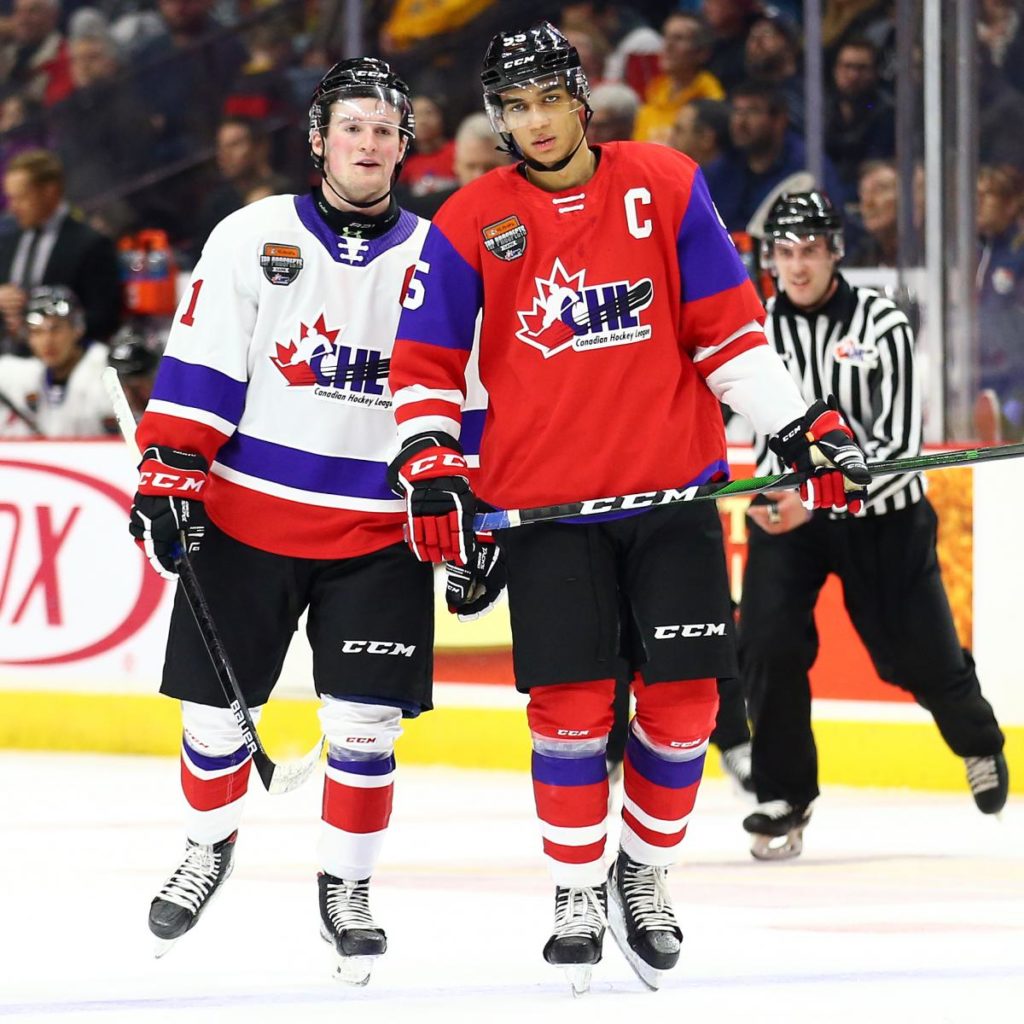
Quinton Byfield and Alexis Lafrenière at the CHL Top Prospects Game. Photo courtesy of the CHL.
His numbers are extremely impressive when you compare them to his closest peer, Lafrenière, at the same age. Both players are highly skilled and productive forwards who make a difference when they are on the ice. Both players deserve to go in the top-two picks on draft night.
Sleep On Byfield At Your Own Risk
Byfield has become a bit of a divisive prospect. While everything from data to video leads me to believe that Byfield should be in the top-two, there are a few outlets and evaluators that do not share that opinion. From mainstream media lists such as TSN’s Craig Button having Byfield at three or other independent scouts on the internet having him outside of that range, everyone is entitled to their opinion. Personally, I disagree.
Quinton Byfield’s game has grown this year. He’s become more aggressive and more predatory as the year wore on. He seemed to take the poor performance at the World Juniors to heart and rejoined Sudbury as strong as ever. Even with a wrist injury and a few other nagging ailments, Byfield was very productive from start to finish this year. When you account for his age, production, physical gifts, and the context around everything, there is no doubt in my eyes that Byfield is the second-best prospect in this draft class at worst. I am also of the belief that the ceiling on the young budding star’s game is higher than anyone else in the class. From his skating and mobility to his shot and passing ability, Byfield is one of the most intriguing prospects in years.
Lafrenière probably deserves to go number one. Byfield deserves to be in the conversation and it shouldn’t be a short conversation.
*******
Thank you for joining me as we dove into the game of Quinton Byfield. He’s a special prospect and has a legitimate shot at being the best player to come from this draft class. Whichever team drafts him will be getting a franchise center build around for years to come. Be sure to check out Dobber’s DraftCast, the new podcast from DobberProspects, powered by InStat! I am joined by my co-host, Jokke Nevalainen, and we dive into all things NHL Draft. We recently had Jimmy Hamrin from McKeens on to talk about Swedish prospects eligible for the 2020 NHL Draft as well as a peak at 2021 and 2022. We also had Chris Peters from ESPN on the show to talk about the continued rise of the U.S. prospect pipeline!
For your fantasy hockey needs, the DobberProspects Fantasy Prospect Report and Fantasy Guide are the best sources to get you ahead of the game in your league whether you play in a simple year-to-year league or you’re involved in a decade long keeper league, the DobberProspects’ Fantasy Guides are your one-stop-shop for winning your league!
Shot chart and statistics such as passing percentage and challenge rate courtesy of InStat Hockey, a top of the line video and scouting platform. For more from InStat, follow them on Twitter. For more on prospects and the NHL Draft, you can follow Tony Ferrari on Twitter.
Draft Class Deep Dives
LHD Jake Sanderson RHD Jamie Drysdale
C Mavrik Bourque RW Dawson Mercer
RW Jacob Perreault RHD Braden Schneider



